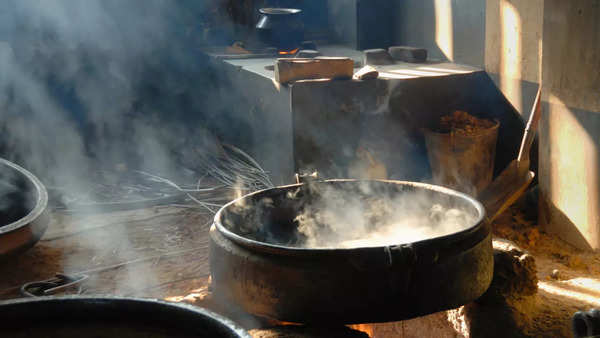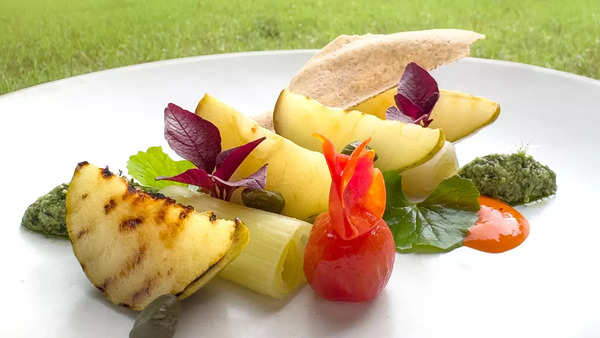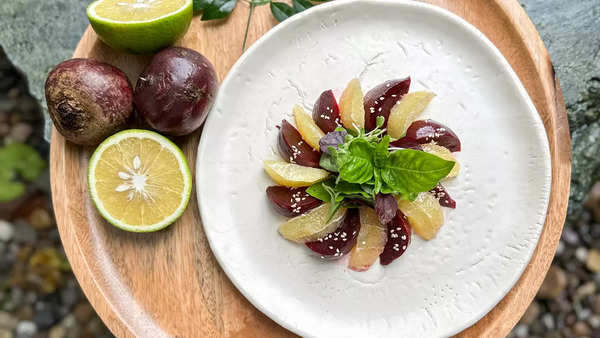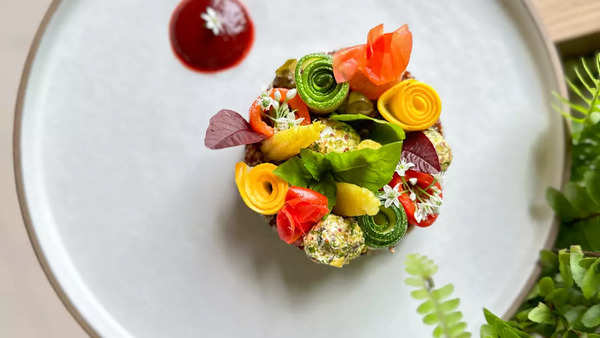Ayurvedic cuisine is a central aspect of Ayurveda. It focuses on preparing and consuming food in a way that promotes health, balance and harmony. It is not just about what you eat, but also how and when you eat. In Ayurveda, food is considered medicine. The diet is designed to balance a person’s doshas – Vata, Pitta and Kapha. Vata-pacifying foods include warm, moist and grounding foods like cooked grains, root vegetables and healthy fats. Pitta-pacifying foods include cooling, hydrating foods like sweet fruits, leafy vegetables and dairy products. Kapha-pacifying foods include light, dry and warm foods like pulses, bitter greens and spices. Chef Rajesh Sharma, Director of Food & Beverage at Six Senses Vana, Dehradun, talks to us in an exclusive conversation about the Ayurvedic way of life and how to incorporate it into your daily cooking.
Read also:9 Dietary Rules for Changeable Weather Suggested by an Ayurveda Expert

How can Ayurvedic cuisine be integrated into your everyday diet?
Ayurveda is one of the oldest schools of healing in the world. It has been time tested for thousands of years. Determining the constitution of the doshas (bio-energies – Vata, Pita or Kapha) in one’s body is the first step towards integrating them into daily life. This can be easily achieved by consulting an Ayurvedic doctor. After the consultation, one needs to follow a diet that pacifies a particular dosha, e.g. Vata should eat warm and grounding meals, Pita should enjoy a cooling and nourishing diet and Kapha should enjoy a lighter and stimulating diet. Once this work is done, one needs to apply these concepts to their daily life or their ‘Dincharya’ as well as their life through the seasons or their ‘Ritucharya’. The food around us changes with the seasons and these variations are reflected in our metabolism. Therefore, both the systems need to work harmoniously while keeping in mind the constitution of the body. All of this may be difficult to understand or follow at first, but with the help of an Ayurvedic doctor/mentor, you will become more conscious of making the right food choices.
Can everyday dishes prepared with a minimum of spices be made tasty?
Ayurveda teaches us to create the right balance that suits our ‘dosha’ and practice moderation. Even healthy foods can cause imbalance if consumed in excess. Practice moderation and variety in your diet. The reason we include spices in our daily diet is to improve digestion and get maximum benefits from the foods we eat. While turmeric, ginger, black pepper, cumin, cinnamon, fennel and coriander are considered super spices, other spices are used in combination with them. Some of the best ways to cook with spices in moderation are:
⦁ Layered flavors: Start with whole spices like cumin or mustard seeds in hot oil to release their flavor, then add ground spices to create a more intense flavor.
⦁ Balance spice and sweetness: By adding a sweet note, such as honey or palm sugar, you can balance out the spiciness of the spices.
⦁ Use fresh spices: Freshly ground spices have more power and flavor than pre-ground ones. For the best taste, grind your spices at home.
⦁ Experiment with spice blends: Create your own spice blends like Garam Masala or Chai Masala to quickly enhance the taste
What are some of the essential components of an Ayurvedic diet?
An Ayurvedic diet emphasizes balance, harmony and nutrition, using foods and spices that support the body’s natural rhythm and constitution. Essential ingredients may include whole grains and millets, legumes, herbs and spices, seasonal vegetables and fruits, dairy products (such as ghee, yogurt and milk), nuts and seeds, oils, sweeteners and herbal teas.
How do you prepare a meal to get the maximum nutritional value from vegetables?
Ayurveda emphasizes that the way foods are prepared and cooked can have a major impact on their nutritional value and absorption by the body. Some of the techniques used to maximize nutritional value include steaming, blanching, grilling, sautéing with ghee, marinating, using seasonal produce, using herbs and spices or spice blends, and fermenting.
Read also: Ayurveda-inspired nutritional tips for a healthy diet

You are proficient in various healthy cooking styles. Tell us about them.
Ayurvedic cuisine changes with each of the five seasons (summer, monsoon, autumn, winter, spring) and continues to evolve even 10 years after its inception. Our cooking style includes:
⦁ Slow cooking – Cooking legumes and root vegetables at low temperatures in thick-bottomed pots in the oven or over a direct flame with a lid helps break down the fiber, making it easier to digest and developing a more complex flavor.
⦁ Fermentation – Indian pickles (amla, cauliflower, lime, mango) | Sauerkraut – made from white cabbage and turmeric, red cabbage and cumin | Beverages – kombucha, kefir, coconut yogurt, tepache, ginger beer | Miso paste made from chickpeas and kabuli chickpeas | Tempeh made from local rajma. The properties, flavor profile and overall characteristics of an ingredient change through fermentation.
⦁ Minimalist Cooking – Lightly cooking vegetables preserves the natural enzymes that can aid digestion. Overcooking can destroy these enzymes and reduce nutrient content.
Share your 3 favorite salad recipes.
Grilled pear and leek salad, basil pesto, mesclun

Ingredients
2 large pears, cut into wedges, grilled
4 leeks (white part only), cooked for 10-12 minutes
2 tbsp balsamic vinegar
4 tbsp extra virgin olive oil
1 cup mesclun (mixed salad)
2 tbsp basil pesto
Gluten-free crackers
Salt and pepper to taste
Proceedings
⦁ Heat an iron plate over a very high flame and grill the pear slices until lightly charred. Sprinkle a few drops of olive oil over them. Season.
⦁ Allow the leek to cool and cut into 5 cm long strips. Grill the leek in a medium-hot pan until lightly charred.
⦁ Now add balsamic vinegar, the remaining EVOO, salt and pepper to a mixing bowl and whisk well.
⦁ Arrange the pears and leeks in a pasta bowl in a pretty pattern. Drizzle the dressing over the mesclun and place on top. Serve the pesto and gluten-free crackers with the salad.
Beetroot and lime salad, mesclun, roasted sesame

Ingredients
⦁ 4 medium-sized beetroots cooked and peeled
⦁ Bundle of mixed salad refreshed
⦁ 18-20 orange or lime segments
⦁ 1 tbsp feta cheese crumbled
⦁ Crush a pinch of black pepper
⦁ Pinch of sea salt
⦁ 3 tbsp vinaigrette
⦁ 1 tsp roasted sesame seeds
⦁ Microgreens for garnish.
Proceedings
⦁ Arrange the prepared salad in a chilled serving bowl.
⦁ Cut the beetroot into 1×8 wedges. Place the beetroot in a bowl, add half of the vinaigrette and mix well.
⦁ Place the marinated beetroot groves around the salad, add sweet lime or orange pieces and sprinkle with grated feta cheese.
⦁ Season with salt and pepper. Drizzle the rest of the vinaigrette over the lettuce leaves and garnish with toasted sesame seeds and microgreens.
Orange vinaigrette
Ingredients
⦁ 3/4 cup extra virgin olive oil
⦁ 1/4 cup orange juice
⦁ 2 tsp brown sugar
⦁ 1 tsp mustard paste
⦁ Salt to taste
⦁ Pepper to taste
Proceedings
⦁ 1. Place all ingredients in a blender and blend for about 10 seconds or until well combined.
⦁ 2. Place in a bowl and let rest for 30 minutes to allow the flavors to blend.
⦁ 3. Whisk the dressing well before serving.
Red quinoa salad, labneh, mesclun

Ingredients
¼ cup white quinoa
¼ cup red quinoa
½ tsp lemon peel
2 tablespoons extra virgin olive oil
1 tbsp parsley, chopped
1 tsp lime juice
½ piece of green zucchini
½ piece yellow zucchini
½ cherry tomatoes
¼ cup thawed yogurt
½ tsp Zatar spice mix
½ cup mesclun (mixed)
Salt and pepper to taste
Proceedings
1. Wash and clean the quinoa and soak it in warm water for 10 minutes. Put the soaked quinoa in a pot, add twice the amount of water and cook the soaked grain with the lid closed until it begins to pop.
2. Cut the zucchini into ¼ cm thick strips and grill in a medium-hot pan until lightly browned. Drizzle with extra virgin olive oil. Season. Roll into pinwheels.
3. Heat a separate pan over high heat and add cherry tomatoes. Cook the tomatoes for 60 to 90 seconds or until they blister and drizzle a few drops of EVOO over the top. Season to taste.
4. In a bowl, mix the suspended yogurt and za’atar spice well. Add a few drops of EVOO to your palm and divide the yogurt into small balls to form labneh balls.
4. Place quinoa, lemon zest, lemon juice, chopped parsley and EVOO in a mixing bowl and mix well. Add seasonings. Using a 3-inch diameter pastry cutter, shape the quinoa salad into a thick round disk on a plate.
5. Arrange zucchini rolls, tomatoes, labneh balls and mesclun on the quinoa salad.

